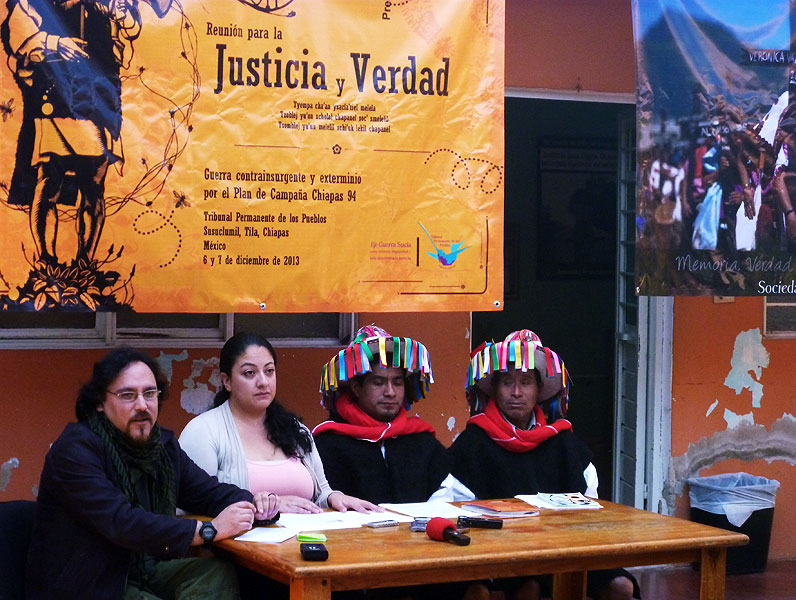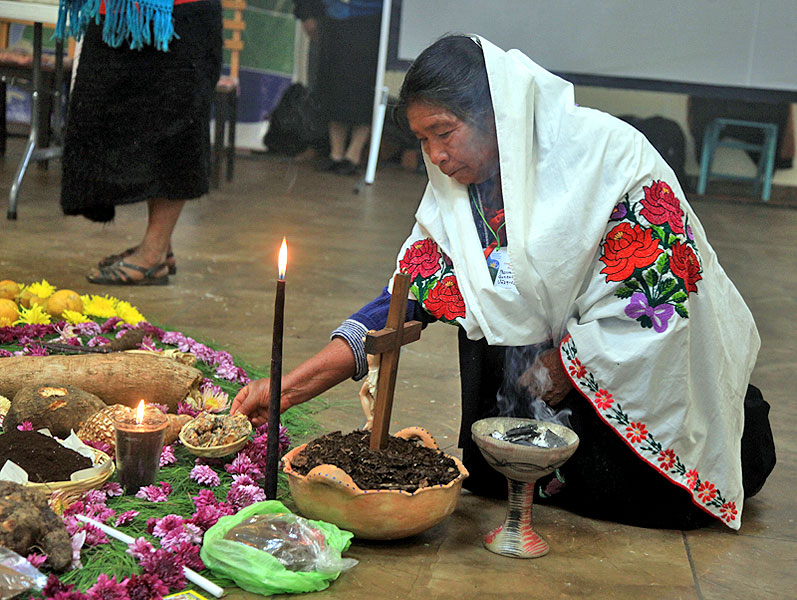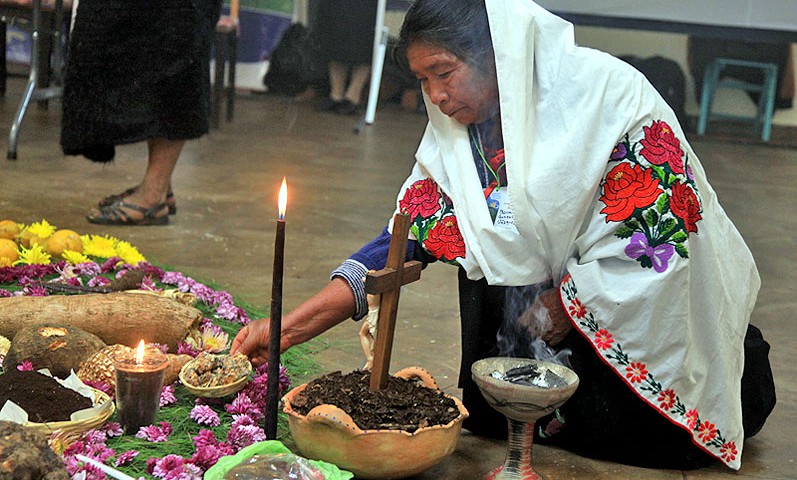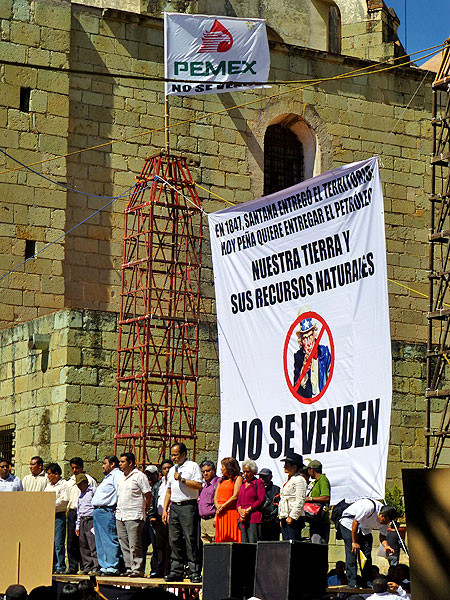
In Focus: Preaudience of the People’s Permanent Tribunal: “Meeting for Justice and Truth”
21/02/2014SIPAZ ACTIVITIES (From mid-November 2013 to mid-February 2014)
21/02/2014“Amidst the power of the transnational firms and the governments allied and complicit with these, […] it is necessary that we have the courage to stand up to them […].”
“DREAM, THAT WITH LOVE
WE CARE FOR THIS EARTH
DREAM THAT IN THE END WE WILL STOP
DESTROYING HER
DREAM THAT A NEW WORLD IS POSSIBLE
DREAM A NEW CREATION.
STRUGGLE SO THAT FINALLY THE POWERFUL
OF THE WORLD UNDERSTAND, STRUGGLE
LIFE MATTERS MORE THAN DOES MONEY,
STRUGGLE SO THAT WE BE PART OF THIS LAND,
STRUGGLE, BECAUSE IF SHE DIES SO WILL YOU.”
Song at the Congress for Mother Earth
In January 2014 there was celebrated the Pastoral Congress for Mother Earth as organized by the San Cristóbal de las Casas diocese in Chiapas. This congress was held to commemorate the Indigenous Congress of 1974, which carried with it both a past and a future for the diocese, as for the lives of the indigenous peoples of the region. The Congress for Mother Earth also coincided with the third anniversary of the death of jTatik Samuel Ruiz García.

© Diócesis de San Cristóbal de Las Casas
The Indigenous Congress was held on 14 October 1974 in San Cristóbal de Las Casas toward the end of celebrating the 500 years since the birth of Fray Bartolomé de Las Casas, the first Catholic bishop in the zone who is known as a “defender of the Indians.” In that time, the Congress was organized for and by indigenous peoples. An estimated 250,000 indigenous people participated, under the guidance of jTatik Samuel (or “Father Samuel” in the indigenous languages), bishop of the San Cristóbal diocese. For the first time, Tsotsil, Tseltal, Tojolabal, and Ch’ol individuals met each other and realized that they faced very similar problems in terms of economic, political, and social marginalization. The meeting gave rise to the birth of different indigenous and campesino organizations such as Quiptik, the Rural Association of Collective Interest (ARIC), the Independent Center of Agricultural and Campesino Workers (CIOAC), the Emiliano Zapata Campesino Organization (OCEZ), and also the Zapatista Army of National Liberation (EZLN).
The land was a central theme in both congresses, given that, though some aspects of the lives of indigenous communities have changed in these 40 years, many problems continue. The objective of this year’s congress was described in these terms: “Amidst the increasing aggression and destruction directed against our Mother Earth; and inspired by the word of God , the leadership of the Church, the diocene pre-Congresses, and the Indigenous Congress, we [seek to] share the situation and reality of our Mother Earth today and the experiences that are being taken to care and defend for her, to identify the challenges that this reality is presenting to us, and to suggest agreements and actions to promote the defense and care of our Mother Earth, which gives life in abundance.”
At the event more than a thousand persons participated, coming from different parishes in the state of Chiapas, in addition to those invited from other countries of the continent, such as the bishop of Patagonia, Argentina, who shared his reflection regarding the theme of “Energy resources, mega-projects, and water.” Álvaro Ramassini, bishop of Huehuetenango, Guatemala, spoke of the movement against mining in his pastoral zone.
© SIPAZ
The analysis of reality allowed for the identification of new environmental problems such as deforestation, soil erosion, forest fires, the drying-up of rivers and arroyos, mining projects, and above all the construction of highways. In the communities, governmental assistance projects and megaprojects are often considered as death projects due to their impacts on communal life, unity, and organizational processes. Moreover, it was denounced that the indigenous are rarely consulted in accordance with international law, such as Convention 169 of the International Labor Organization (ILO), as the government is obligated to do. It was also noted that gender equality has progressed little if at all. Some participants noted that “We also have the task of constructing the reign of God.” Furthermore, it was stressed that generational problems have been exacerbated, thus limiting the participation of youth. Specific work-tables were arranged for these two groups, considered vulnerable for multiple reasons.
The document arranged for the pre-congresses held last year in the pastoral zones notes that “The crisis situation we are experiencing we could compare with a large fire. Given the measures that have been taken during these five years (billions of dollars invested to rescue the banks and large firms), these have served only to try to put out a fire that rages everywhere. But later it will become necessary to review the house and take account of the damages caused, to see what will be needed for reconstruction, and to analyze if the existing structures will function adequately or if they will need to be remade from the ground up. We must think hard on how to rebuild this house.”
Among the agreements made by those participating in the Congress are found those of raising the consciousness of families and communities regarding existing problems, organizing communities to care for and defend Mother Earth, pursuing unity among political, ideological, and religious differences, and articulating and reorganizing all the parishes to observe the agreements taken at the Congress. In this way, it was decided to block mining operations and governmental policies which negatively affect the interests of communities: “We oppose mega-projects and devastating mineral exploitation. We oppose the structural reforms proposed by the government to promote the interests of the dominant classes, in opposition to the people. We pronounce ourselves in resistance to these more than 20 years of neoliberal agrarian reform which has ignored us completely as indigenous peoples, campesino communities, and Mexicans.”


